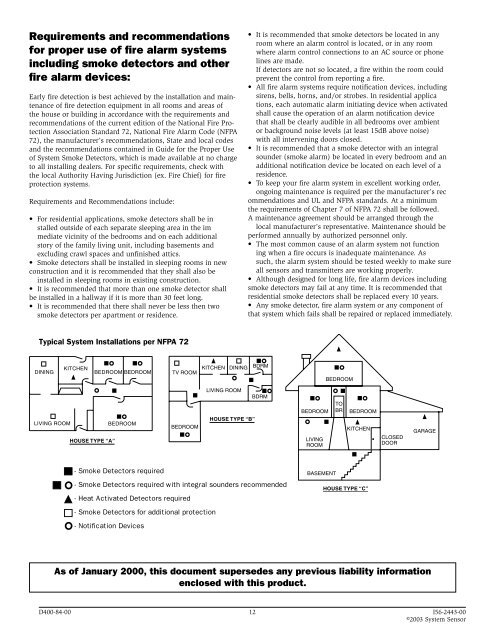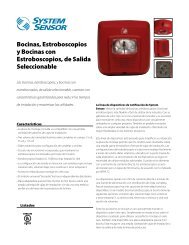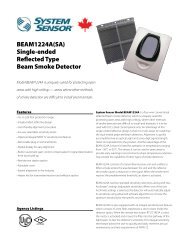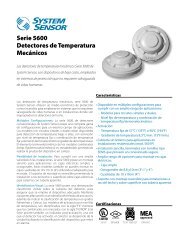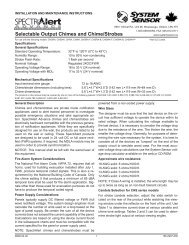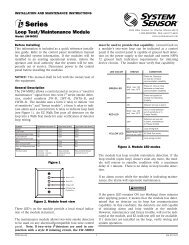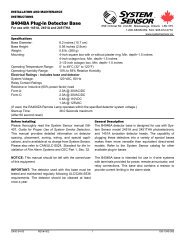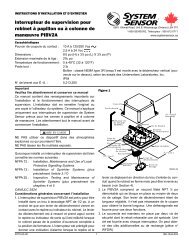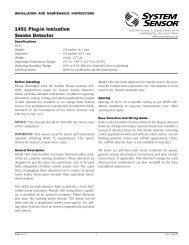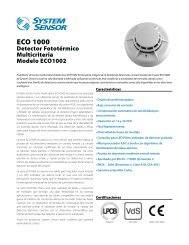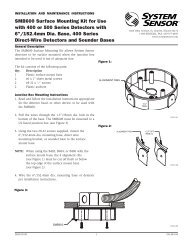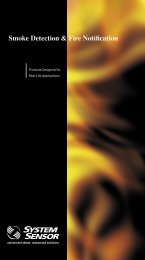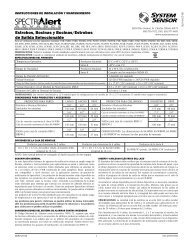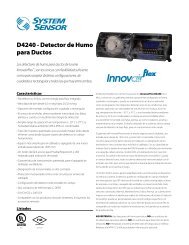DH100ACDCLPX Air Duct Smoke Detector with Extended Air Speed ...
DH100ACDCLPX Air Duct Smoke Detector with Extended Air Speed ...
DH100ACDCLPX Air Duct Smoke Detector with Extended Air Speed ...
Create successful ePaper yourself
Turn your PDF publications into a flip-book with our unique Google optimized e-Paper software.
Requirements and recommendations<br />
for proper use of fire alarm systems<br />
including smoke detectors and other<br />
fire alarm devices:<br />
Early fire detection is best achieved by the installation and maintenance<br />
of fire detection equipment in all rooms and areas of<br />
the house or building in accordance <strong>with</strong> the requirements and<br />
recommendations of the current edition of the National Fire Protection<br />
Association Standard 72, National Fire Alarm Code (NFPA<br />
72), the manufacturer’s recommendations, State and local codes<br />
and the recommendations contained in Guide for the Proper Use<br />
of System <strong>Smoke</strong> <strong>Detector</strong>s, which is made available at no charge<br />
to all installing dealers. For specific requirements, check <strong>with</strong><br />
the local Authority Having Jurisdiction (ex. Fire Chief) for fire<br />
protection systems.<br />
Requirements and Recommendations include:<br />
• For residential applications, smoke detectors shall be in<br />
stalled outside of each separate sleeping area in the im<br />
mediate vicinity of the bedrooms and on each additional<br />
story of the family living unit, including basements and<br />
excluding crawl spaces and unfinished attics.<br />
• <strong>Smoke</strong> detectors shall be installed in sleeping rooms in new<br />
construction and it is recommended that they shall also be<br />
installed in sleeping rooms in existing construction.<br />
• It is recommended that more than one smoke detector shall<br />
be installed in a hallway if it is more than 30 feet long.<br />
• It is recommended that there shall never be less then two<br />
smoke detectors per apartment or residence.<br />
• It is recommended that smoke detectors be located in any<br />
room where an alarm control is located, or in any room<br />
where alarm control connections to an AC source or phone<br />
lines are made.<br />
If detectors are not so located, a fire <strong>with</strong>in the room could<br />
prevent the control from reporting a fire.<br />
• All fire alarm systems require notification devices, including<br />
sirens, bells, horns, and/or strobes. In residential applica<br />
tions, each automatic alarm initiating device when activated<br />
shall cause the operation of an alarm notification device<br />
that shall be clearly audible in all bedrooms over ambient<br />
or background noise levels (at least 15dB above noise)<br />
<strong>with</strong> all intervening doors closed.<br />
• It is recommended that a smoke detector <strong>with</strong> an integral<br />
sounder (smoke alarm) be located in every bedroom and an<br />
additional notification device be located on each level of a<br />
residence.<br />
• To keep your fire alarm system in excellent working order,<br />
ongoing maintenance is required per the manufacturer’s rec<br />
ommendations and UL and NFPA standards. At a minimum<br />
the requirements of Chapter 7 of NFPA 72 shall be followed.<br />
A maintenance agreement should be arranged through the<br />
local manufacturer’s representative. Maintenance should be<br />
performed annually by authorized personnel only.<br />
• The most common cause of an alarm system not function<br />
ing when a fire occurs is inadequate maintenance. As<br />
such, the alarm system should be tested weekly to make sure<br />
all sensors and transmitters are working properly.<br />
• Although designed for long life, fire alarm devices including<br />
smoke detectors may fail at any time. It is recommended that<br />
residential smoke detectors shall be replaced every 10 years.<br />
• Any smoke detector, fire alarm system or any component of<br />
that system which fails shall be repaired or replaced immediately.<br />
Typical System Installations per NFPA 72<br />
DINING<br />
KITCHEN<br />
BEDROOM BEDROOM<br />
TV ROOM<br />
KITCHEN DINING BDRM<br />
BEDROOM<br />
LIVING ROOM<br />
BDRM<br />
BEDROOM<br />
TO<br />
BR<br />
BEDROOM<br />
LIVING ROOM<br />
BEDROOM<br />
BEDROOM<br />
LIVING<br />
ROOM<br />
KITCHEN<br />
CLOSED<br />
DOOR<br />
GARAGE<br />
- <strong>Smoke</strong> <strong>Detector</strong>s required<br />
- <strong>Smoke</strong> <strong>Detector</strong>s required <strong>with</strong> integral sounders recommended<br />
- Heat Activated <strong>Detector</strong>s required<br />
- <strong>Smoke</strong> <strong>Detector</strong>s for additional protection<br />
- Notification Devices<br />
BASEMENT<br />
As of January 2000, this document supersedes any previous liability information<br />
enclosed <strong>with</strong> this product.<br />
D400-84-00 12 I56-2443-00<br />
©2003 System Sensor


